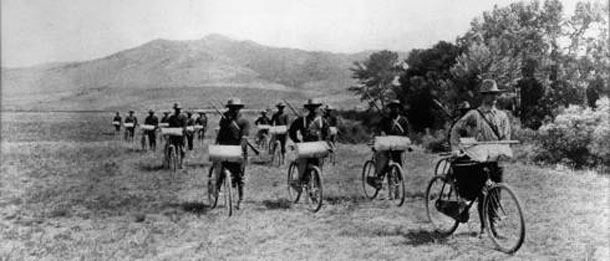THE CYCLING BUFFALO CAVALRY
Formed after the Civil War by an Act of Congress that created 4 regiments of “colored troops”, the Buffalo Soldiers were racially segregated members of the US Army from 1866 until 1951. Led by white officers, these African-American soldiers served with distinction in every American war but were best known for the fierce battles they engaged in during the Indian Wars. Receiving 23 Congressional Medals of Honor during these conflicts, these men earned the reputation for not only providing safety and security to the early western settlers but also for their perseverance and bravery during battles with the Native Americans. It is believed they were given the nickname “buffalo soldiers” by the Cheyenne because their fighting style was similar to a buffalo that is backed into a corner and their dark, curly hair most resembled a buffalo coat.
When the regiments were first formed in 1866, the men enlisted for five years and were paid $13 per month, plus room, board and clothing. Most came from the Southern states and were stationed at military frontier posts from Texas to the Dakotas … sometimes residing in empty cotton presses that had been converted to barracks and were poorly ventilated and rat infested. Most bathed in local creeks, and diseases such as cholera, dysentery, bronchitis and tuberculosis were rampant. Often assigned some of the worst jobs in the worst locations and issued old horses and faulty equipment, these men also endured discrimination and racism on a daily basis by local citizens and law enforcement.
Representing 20% of the cavalry in the American frontier, the Buffalo Soldiers fought not only the Native Indians but also such bandits as Billy the Kid and Pancho Villa. In addition, they helped build roads and forts, strung out telegraph lines for many miles, escorted wagon trains and stage coaches, and found drinkable water. In later years, they fought in Cuba during the Spanish-American War in 1898 but never received any accolades even though they had done the HEAVIEST fighting during Theodore Roosevelt’s charge on San Juan Hill. They also assisted in controlling the Filipino nationalists and served in both World Wars I, II and the Korean War.
Serving briefly as National Park Rangers in California from 1899 to 1904, these men made improvements to the parks and patrolled for loggers and poachers. They are also credited as the original designers of what we now refer to as the “Smokey the Bear Hat”. Although it was not officially adopted by the US Army until 1911, it was first photographed being worn by a Buffalo Soldier in 1899. Originally a Stetson hat, it is believed it was given its distinctive crease (called the “Montana pitch”) in order to shed water from the tropical rains the troops faced in the Spanish-American War.
One of their most notable contributions, and what few historians ever mention, is the fact that they participated in a bicycle troop that carried out extensive cycling journeys in the last decade of the 19th century. Although the UK and France had done some experiments using bicycles in the military as an alternative to horses, the most extensive tests were conducted by First Lieutenant Moss and his eight Buffalo Soldiers in 1896. Stationed at Fort Missoula, Montana and coined the nickname “Iron Riders”, these men set out on a four-day trip to Lake Spalding (a 126-mile journey). Riding one-speed Spaldings loaned to them by the manufacturer in Chicago, each bicycle weighed around 75 pounds, including frame and gear. Although they faced very steep grades and muddy roads, and sometimes resorted to walking their bikes up the railroad tracks instead, it was considered a great success. Soon after, they set out again on a longer trip to Yellowstone National Park, covering 790 miles in 16 days. Once again, they faced many obstacles such as punctured tires, mud, headwinds, and stomach illness but were inspired to keep venturing out further. The following year, in 1897, they more than doubled their troop size and cycled 1,900 miles from Missoula to St. Louis, Missouri in 34 days, averaging 56 miles per day and a speed of 6.3 mph. In the end, they proved that bikes could be used for military purposes on roadless mountainous terrain and could travel faster and at one third the cost of horses.
The last war the Buffalo Soldiers participated in before they were integrated with the white soldiers was the Korean War. The last all-black Army regiment, the 24th Infantry, served on the front lines until they were disbanded on December 12, 1951. Two of these men won the Medal of Honor that same year. By 1960, the US Army was totally integrated.
Copyright © 2013 (Michelle Parsons, Getting Back on Your Path). All Rights Reserved.


Great Article Michelle
Love,
Al